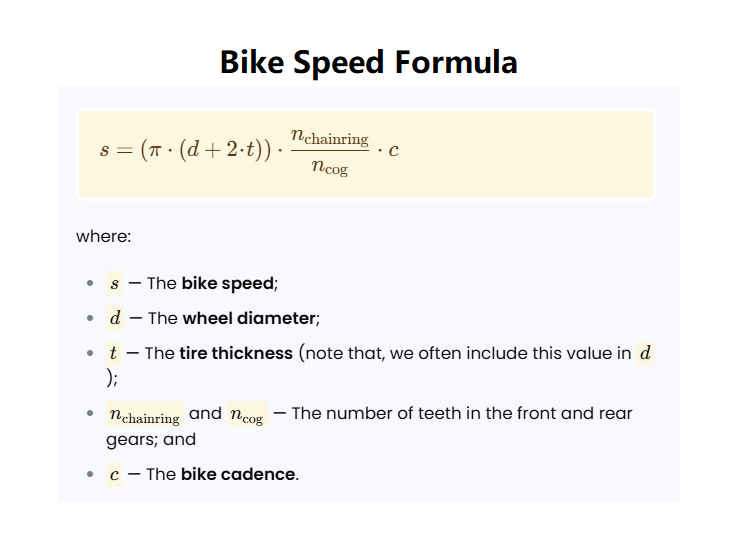1. What is a Bike Speed Calculator?
Definition: The Bike Speed Calculator determines your cycling speed (in m/s, km/h, ft/s, or mph) based on wheel size, gear settings, and cadence, along with the gear ratio.
Purpose: It helps cyclists understand how their bike setup and pedaling rate affect their speed, aiding in performance analysis and gear selection.
2. How Does the Calculator Work?
The calculator uses the following formulas:
\( \text{Gear Ratio} = \frac{\text{Chainring Teeth}}{\text{Cog Teeth}} \)
\( \text{Speed (m/s)} = \text{Cadence (rpm)} \times \text{Gear Ratio} \times \text{Wheel Circumference (m)} \times \frac{1}{60} \)
Where:
- Wheel Circumference = \( \pi \times (\text{Wheel Diameter} + 2 \times \text{Tire Size}) \)
- Speed is then converted to the selected unit (m/s, km/h, ft/s, mph).
Steps:
- Enter the Wheel Diameter, Tire Size (thickness), Chainring teeth, Cog teeth, and Cadence (rpm).
- Select the units for Wheel Diameter and Tire Size (mm, cm, in, ft).
- Choose the speed unit for output (m/s, km/h, ft/s, mph) after the Speed result.
- Validate inputs to ensure they are positive and appropriate (e.g., Chainring and Cog ≥ 1, Cadence ≥ 0).
- Calculate the Gear Ratio and Speed, displaying both results with a unit selection dropdown for Speed.
3. Importance of Bike Speed Calculation
Calculating bike speed is crucial for:
- Performance Optimization: Helps cyclists adjust their gear setup and cadence to achieve desired speeds.
- Training: Allows cyclists to monitor their speed and improve efficiency during rides.
- Bike Setup: Assists in choosing the right wheel size and gear ratios for specific riding conditions.
4. Using the Calculator
Example 1: A cyclist uses a wheel diameter of 26 inches, tire size of 1 inch, chainring of 48 teeth, cog of 16 teeth, and cadence of 90 rpm, outputting in km/h:
- Wheel Diameter: 26 in = 0.6604 m
- Tire Size: 1 in = 0.0254 m
- Total Diameter: \( 0.6604 + (2 \times 0.0254) = 0.7112 \, \text{m} \)
- Circumference: \( \pi \times 0.7112 \approx 2.234 \, \text{m} \)
- Gear Ratio: \( \frac{48}{16} = 3 \)
- Speed (m/s): \( 90 \times 3 \times 2.234 \times \frac{1}{60} \approx 10.05 \, \text{m/s} \)
- Speed (km/h): \( 10.05 \times 3.6 \approx 36.18 \, \text{km/h} \)
Example 2: A cyclist uses a wheel diameter of 700 mm, tire size of 25 mm, chainring of 52 teeth, cog of 12 teeth, and cadence of 80 rpm, outputting in mph:
- Wheel Diameter: 700 mm = 0.7 m
- Tire Size: 25 mm = 0.025 m
- Total Diameter: \( 0.7 + (2 \times 0.025) = 0.75 \, \text{m} \)
- Circumference: \( \pi \times 0.75 \approx 2.356 \, \text{m} \)
- Gear Ratio: \( \frac{52}{12} \approx 4.33 \)
- Speed (m/s): \( 80 \times 4.33 \times 2.356 \times \frac{1}{60} \approx 13.61 \, \text{m/s} \)
- Speed (mph): \( 13.61 \times 2.23694 \approx 30.45 \, \text{mph} \)
5. Frequently Asked Questions (FAQ)
Q: What is a typical cadence for cycling?
A: A typical cadence for recreational cyclists is 60-100 rpm, while competitive cyclists often aim for 80-120 rpm.
Q: Why can I change the speed unit after calculation?
A: The unit selection dropdown after the Speed result allows you to convert the speed into your preferred unit (m/s, km/h, ft/s, mph) without recalculating other values like Gear Ratio.
Q: Does this calculator account for terrain or wind?
A: No, this calculator assumes flat, windless conditions. Real-world speeds may vary due to terrain, wind, and other factors.
 Home
Home
 Back
Back
